NALOXONE – Frequently Asked Questions & Resources
Check out our pre-recorded webinar: The Opioid Crisis, COVID-19 and Naloxone Training
What is Naloxone?
Naloxone is a medication used to temporarily reverse the effects of an opioid/opiate overdose. Opioids and opiates are substances like: opium, fentanyl, carfentanyl, heroin, oxycodone, codeine, morphine, methadone, hydromorphone, dilaudid, percocet. 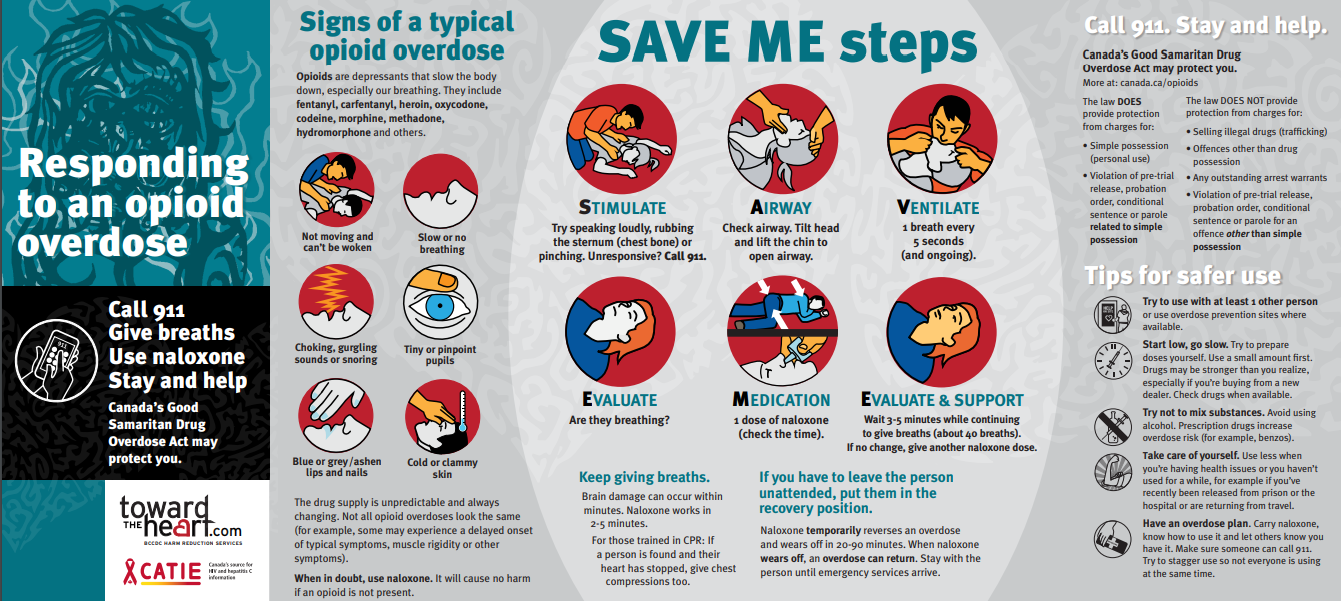 https://orders.catie.ca/book/responding-to-an-opioid-overdose-responding-to-stimulant-overuse-and-overdose/
https://orders.catie.ca/book/responding-to-an-opioid-overdose-responding-to-stimulant-overuse-and-overdose/
What are the symptoms of an opioid overdose?
- Loss of consciousness
- Unresponsive to outside stimulus, like a sternum rub
- Awake, but unable to talk
- Breathing is very slow and shallow, erratic, or has stopped
- For lighter skinned people, the skin tone turns bluish purple, for darker skinned people, it turns grayish or ashen.
- Choking sounds, or a snore-like gurgling noise (sometimes called the “death rattle”)
- Vomiting
- Body is very limp (sometimes in an atypical overdose, the body may become rigid)
- Face is very pale or clammy
- Fingernails and lips turn blue or purplish black
- Pulse (heartbeat) is slow, erratic, or not there at all
How does Naloxone work?
Our brains have receptors, or areas that opioids fit nicely into. When those receptors are covered, this is when we feel the side effects of opioids; we feel pain relief, depressed breathing and heart rate, and euphoria. When an individual is in an overdose state, they have too many of these brain receptors covered by the opioid. Naloxone temporarily removes opioids from brain receptors.
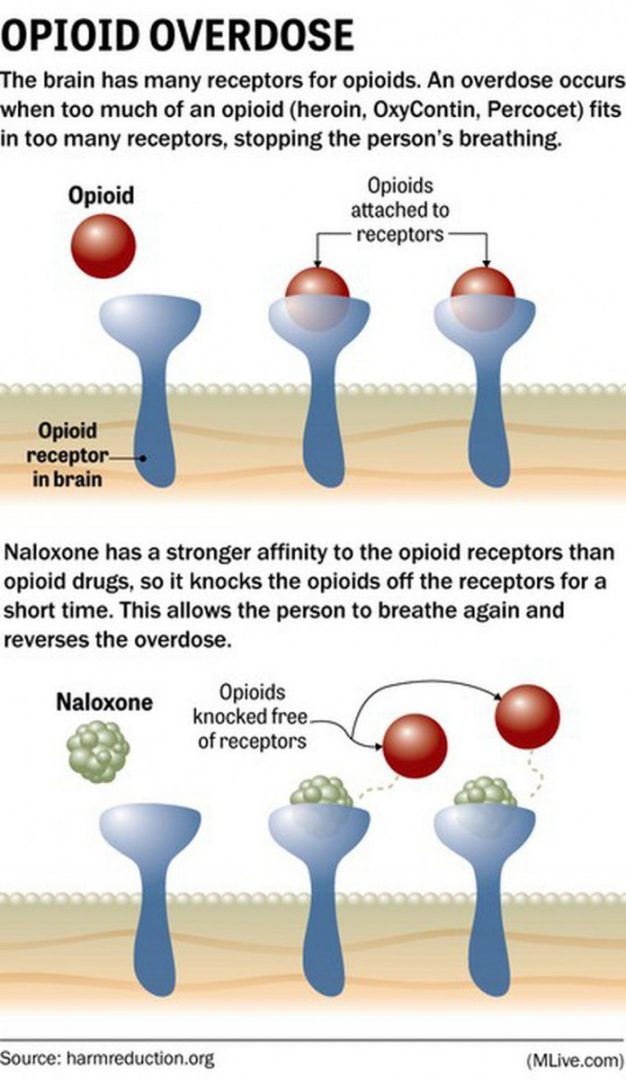
It is important to remember that Naloxone only lasts from 30-90 minutes. When the Naloxone wears off, it is possible to go back into the overdose state because the opioid is still in the brain.
Are there any side effects of Naloxone?
There are no side effects directly caused by Naloxone. However, because the opioids have been removed from the receptors in the brain, the individual will no longer feel the effects of the opioid. Withdrawal symptoms can occur. Opioid withdrawal symptoms can include:
- Anxiety
- Goosebumps
- Restlessness
- Insomnia
- Yawning
- Body aches
- Sweating
- Vomiting
- Diarrhea
- Fever
- Shaking
- Faster-than-normal heartbeat
- Rapid breathing
- High blood pressure
Will Naloxone help or make worse any other medical emergency?
Naloxone will only work to temporarily reverse an opiate/opioid overdose. Opioids and opiates are substances like: opium, fentanyl, carfentanyl, heroin, oxycodone, codeine, morphine, methadone, hydromorphone, dilaudid, percocet. With an unregulated street drug supply, it is possible for opioids to be found in other substances like crystal methamphetamine and cocaine. If an individual uses a stimulant like cocaine or crystal meth and they experience opioid overdose symptoms, this is likely due to contamination. It is recommended to administer naloxone to mitigate the opioids effects. If someone is experiencing a stimulant overdose, or is overamping, naloxone will not help. This is still a medical emergency, and medical attention is needed. 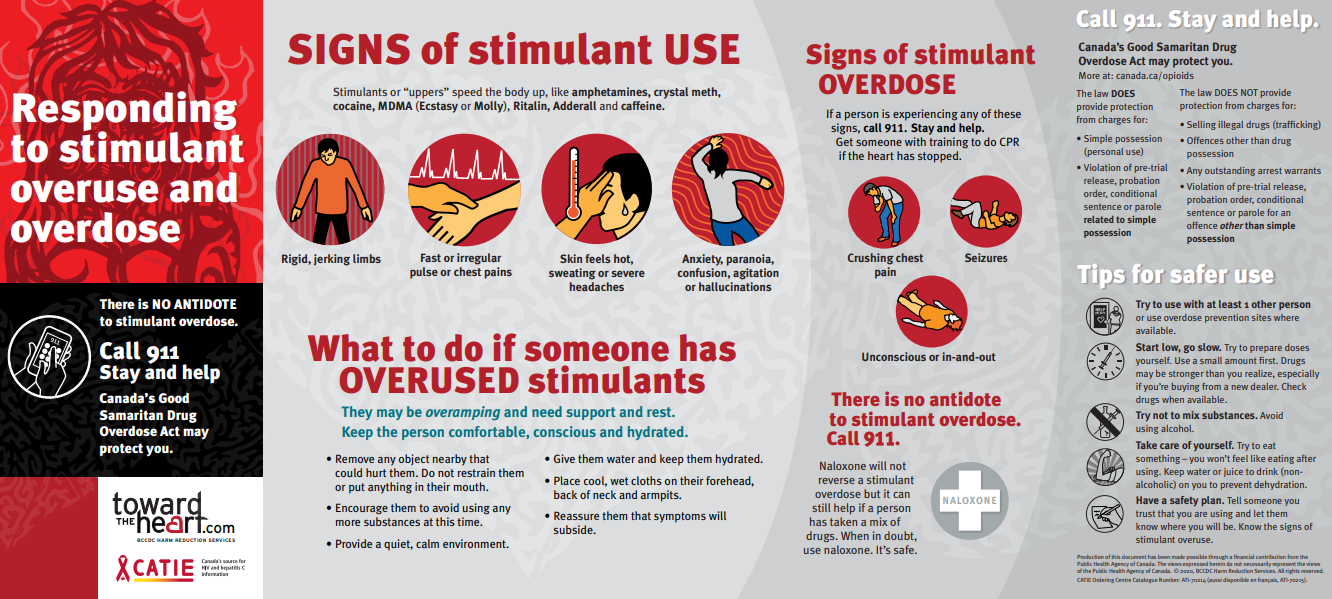 https://orders.catie.ca/book/responding-to-an-opioid-overdose-responding-to-stimulant-overuse-and-overdose/
https://orders.catie.ca/book/responding-to-an-opioid-overdose-responding-to-stimulant-overuse-and-overdose/
If naloxone is administered to someone who is not experiencing an opiate overdose, it will not cause any additional harm.
Are Naloxone and NARCAN the same thing?
Yes. The names are often used interchangeably. Naloxone is sometimes considered the generic version of the medication, and NARCAN is like the ‘brand name’ version of the medication. Naloxone is also more commonly associated with the injectable version of the medication, whereas NARCAN is associated with the nasal spray. 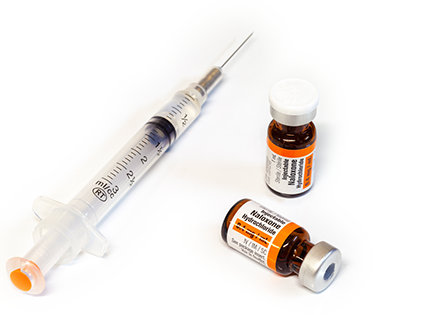
www.narconon.org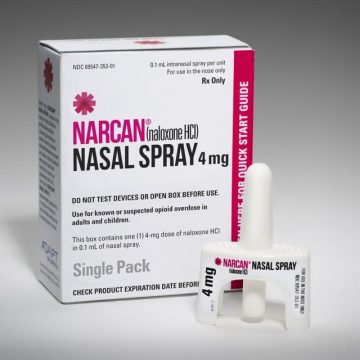 https://www.forbes.com/sites/cjarlotta/2016/04/17/using-naloxone-narcan-as-a-last-resort/#234ba8692138
https://www.forbes.com/sites/cjarlotta/2016/04/17/using-naloxone-narcan-as-a-last-resort/#234ba8692138
Where can I get Naloxone?
You can get an injectable Naloxone kit from us and receive training on how to use it! Call us, message us on Facebook, or send an email to education.gp@northreach.ca (Grande Prairie) or odprevention.fm@northreach.ca (Fort McMurray). You can also access it at most pharmacies for free. Some pharmacies will also order NARCAN nasal spray for you. This kit is very expensive, but if you have treaty status benefits it is covered.
Where should I store my Naloxone?
It is recommended to store Naloxone at room temperature and avoid freezing it or getting it too warm. More information can be found in this storage recommendations document. If you are responding to an overdose and you suspect or know that the kit has experienced extreme temperatures or is expired – still use the kit. The effectiveness of the medication may be altered, but may still help reverse the overdose with more doses.
Resources used for this page and for more information regarding Naloxone:
ACCH Report: A Report on the Effectiveness of the Community-Based Take Home Naloxone Program